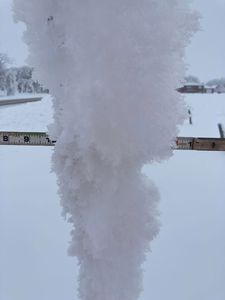This January, hoarfrost and freezing rain in southwestern Manitoba caused a buildup of more than six inches of frost on many of our power lines. Crews removed ice from power lines as quickly as possible to prevent equipment from breaking and to keep the power on.
Melting ice off power lines in southwestern Manitoba
A Killarney crew captured a video of the ice melting process in action near Cartright, which has received over 2.5 million views across Manitoba Hydro’s social media channels.
How does ice melting work? (For the nerds out there)

It may be pretty, but frost buildup on power lines likes these near Morden can add extra weight to the lines, causing equipment to break.
A controlled short-circuit is placed at one end of a line. The current flow creates a temperature increase that heats up the line and melts the ice. With two crews of three or four people each (one crew working outside on the equipment and the other crew working in a control room), we can melt the ice off 30 to 50 km of line in about three hours, often with no customer outages.
Why do we remove ice from our power lines?

Over six inches of ice buildup on a guy wire near Morden.
Enlarge image: Frost around a wire with a measuring tape behind it.
Ice can weigh down the lines and bring them closer to the ground, which is a safety hazard and can potentially strain or break the poles the lines are on. In high winds, ice can also form into a wing shape, which can cause the lines to “gallop” like a large, electrically charged skipping rope. Galloping lines cause stress on the poles, but also present the risk of the lines touching, shorting, and burning down.
What about ice rolling?

Crews roll ice off the lines at the Winnipeg perimeter in April 2020.
Enlarge image: People in high visibility clothing walk beside and climb a utility pole.
Whether we melt or roll ice depends on wind speed, current temperatures, the amount of ice build-up, location, length and configuration of lines, and our ability to isolate selected lines. There are times when ice melting is not a viable option, so we roll or whack the ice off the lines.
Created in-house at Manitoba Hydro
When we shared the video of ice melting on our social media channels, it received incredible engagement from people curious about how the process works. Across Manitoba Hydro’s social media channels, the video has over 2.5 million views, and plenty of comments from people outside of Manitoba applauding the genius behind our ice melting.
That’s because Manitoba Hydro is a leader in ice melting technology.
“The ice melting processes were developed in-house, and we’ve been melting as far back as the 1970s,” said Daryn Shelvey (Distribution Engineering), who developed a web app that’s used for ice melting. “In 1993, some of our staff even wrote a 130-page paper for the Canadian Electricity Association that was shared with other Canadian utilities as the guide for ice melting.”
It wasn’t always as ingrained of a process as it is now. In one of the early ice melts in the 1970s, Brandon Generating Station was used as a power source for a melt and the shaft of a turbine was accidentally bent.
We now have in-house software that allows us to put in details such as voltages, the outside temperature, the type of ice, and wind speed, and it will let us know how long the ice will takes to melt, and will check the current limits to prevent us from damaging our equipment.
Impact on customers
Ice melting is an example of how we’re providing Energy for Life for our customers in the past, present and future. Thanks to the brains that developed ice melting (and continue to develop it), the power stays on for our customers and we increase the lifespan of our equipment.
Find the ice melting video on LinkedIn, Instagram, Facebook, Twitter, and YouTube.




